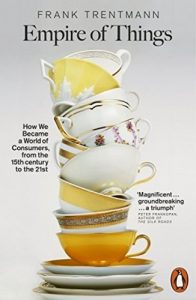Raghuram Rajan is best known for publicly warning of an impending financial crisis in August 2005, at the annual Jackson Hole conference, for which he was mocked by some of the big names present. He then wrote one of the best books about the underlying causes of the crisis, Fault Lines, still well worth reading. Subsequently he was the highly respected central bank governor of India. Not surprisingly, I was very much looking forward to his new book, The Third Pillar: How Markets and the State Leave the Community Behind. The subtitle says it all, and I couldn’t agree more. There is a false dichotomy in much public debate, the claim that organising the economy is a matter of either the state or the market, whereas it is impossible to disentangle the two. But more than this, other non-market, non-state institutions are part of the economic system too. This includes businesses – as Herb Simon once pointed out – but also the kind of institutions Rajan considers in this book, civic and above all local organisations responding to specific local need.
He opens by stating: “In my adult life, I have never been more concerned about the direction our leaders are taking us than I am today.” Surely this sense that capitalism and liberal democracy are fundamentally broken is widespread. The argument here is that part of the solution is to recognise the importance of the neighbourhood and include it as part of the balance of a mixed economy. In a sense community and market are at different ends of a spectrum – from personal relationships to anonymity, Gemeinschaft and Gesellschaft. Rajan argues for some decisions to be taken at the level of the community, rather than the remoter processes of market and state.
The first part of the book is a concise historical survey looking at the emergence of the state and the market. The second part turns to the context of modern capitalism, driven toward the goal of shareholder value maximisation, and fuelled by technological innovation and automation. Rajan is highly critical of the shareholder value mantra – and it’s interesting to see a growing chorus of criticism of Milton Friedman’s toxic contribution to capitalism, such as Colin Mayer’s recent Prosperity. Rajan points out: “When an enormous source of independent power, the private sector, is passive or, worse, rendered suspect in the eyes of the community because its every action has to be in pursuit of corporate profits, there are fewer checks on the arbitrary power of the state.” He argues that the “enormous gamble” states took in the early years of the 21st century – that borrowing in deregulated financial markets would be the source of broad-based sustainable growth – utterly failed. Populism is thus the legacy of the financial crisis.
The book then considers some of the manifestations of the failed gamble, and this echoes a now sadly all too familiary genre studying the decline of communities around all the western economies, such as Janesville and The Unwinding. Rajan advocates the devolution of power, “from the international sphere to nations, and within nations from the federal to the regional to the community level.” The Third Pillar needs to be reinvigorated. There needs to be more scope for people to fill in gaps left by formal economic structures, to experiment with structures of political and economic governance, to create meaningful, non-market local work. I agree with this, again, but the book wisely accepts that this is not easy and local success will be slow. There is a bootstrapping process to get localities onto a virtous circle.
Rajan does not offer specific proposals, and in a way could not because it’s in the nature of local solutions not to be easy to generalise. It would be well worth trying to understand more systematically what kinds of decisions are best taken at what level of governance – as far as I know there is relatively little social science on this, although it’s easy enough to see that, say, climate change policy or digital competition policy needs international co-operation, whereas public services could be far more devolved and differentiated. The issue of Victorian institutional innovation also intrigues me: among the responses to the Industrial Revolution were the emergence of trade unions, mutual savings societies, working men’s literary and philosophical clubs, co-operatives…. is there any comparable social innovation today, and is anybody tracking it and sharing the lessons?
The Third Pillar is published in a couple of weeks, available for pre-order now. It’s author was very right in 2007. He’s very right again now.
[amazon_link asins=’0008276269′ template=’ProductAd’ store=’enlighteconom-21′ marketplace=’UK’ link_id=’e6be7204-05d0-47f3-a2f4-beb8cffcccfe’]

